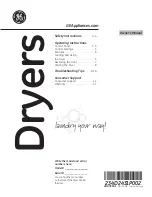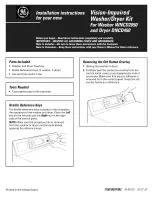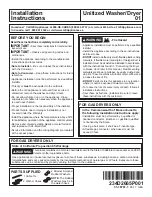
4. If the washer is not level, move the washer out slightly, tip
back, prop up the front of the washer with the wood block and
adjust the feet up or down as necessary by twisting the feet.
Turn the feet clockwise to raise the washer or
counterclockwise to lower the washer. Repeat steps
1 through 4 until washer is level.
5. After the washer is in its final location and level, use a 14 mm
or
⁹⁄₁₆
" open-end wrench to turn the nuts counterclockwise on
the feet tightly against the washer cabinet.
IMPORTANT: If the nuts are not tight against the washer
cabinet, the washer may vibrate.
Complete Installation
1. Check the electrical requirements. Be sure that you have the
correct electrical supply and the recommended earthing
method. See “Electrical Requirements.”
2. Check that all parts are now installed. If there is an extra part,
go back through the steps to see which step was skipped.
3. Check that you have all of your tools.
4. Check that the yellow shipping strap was completely removed
from the lower back of the washer.
5. Dispose of or recycle all packaging materials.
6. Check that the water faucets are on.
7. Check for leaks around faucets and inlet hoses.
8. Plug into an earthed outlet.
9. Remove the protective film on the console and any tape
remaining on the washer.
10. Read “Washer Use” in the Washer User Instructions.
11. To test and to clean your washer, measure
¹₂
of the normal
recommended amount of powdered or liquid detergent and
pour it into the washer basket or detergent dispenser (on
some models). Close the lid. Select any cycle, and then pull
the cycle control knob out to start the washer. Allow it to
complete one whole cycle.
WARNING
Electrical Shock Hazard
Electrically earth this appliance.
Do not use an extension cord or an electrical portable
outlet device.
Failure to follow these instructions can result in death,
fire, or electrical shock.
8316566
© 2005 Whirlpool Corporation.
Benton Harbor, Michigan 49022
8/05
Printed in U.S.A.


























